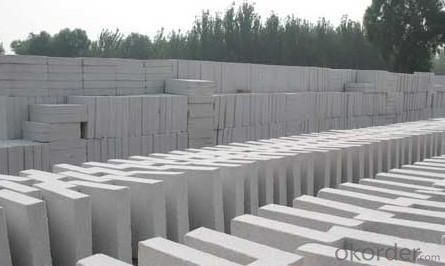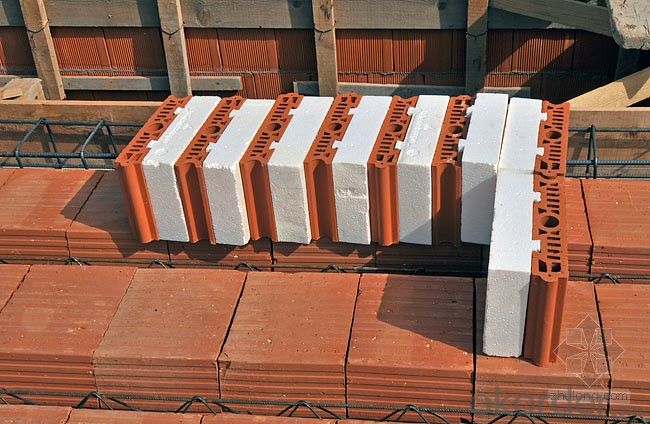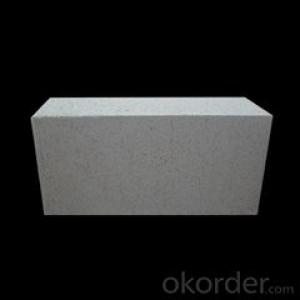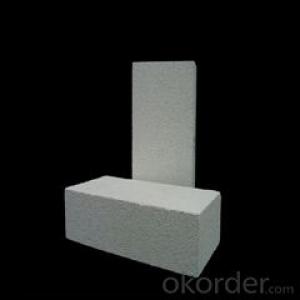Refractory mullite insulating refractory brick JM 88
- Loading Port:
- Shanghai
- Payment Terms:
- TT OR LC
- Min Order Qty:
- 5000 kg
- Supply Capability:
- 10000 kg/month
OKorder Service Pledge
OKorder Financial Service
You Might Also Like
Refractory mullite insulating refractory brick JM 23
Okorder series heat insulation brick
Okorder series thermal insulation brick is an effective, energy saving, low carbon, environmental protection advanced, according to the ASTM standard manufacturing products. Okorder series products are best Li Ning and insulation in all types of industrial furnaces in the metallurgical field, aluminum, petrochemical, electric power and glass ceramic materials. They can be used as part of the working layer of thermal insulation or non - melting. Products have been widely used in the following furnace, achieved satisfactory results.
Application of heat preservation brick
Metallurgical Industry: blast furnace, hot blast furnace, heating furnace, etc..
Petrochemical Industry: ethylene cracking furnace, hydrogen production furnace, primary reformer, heating furnace, etc..
Ceramic industry: roller kiln, kiln, etc..
Glass industry: glass furnace regenerator, etc.
Carbon industry: carbon furnace, etc..
Aluminum electrolysis industry: aluminum reduction cell, etc.
Other industries: tunnel kiln, shuttle kiln, etc..
Advantages of heat insulation brick
Low thermal conductivity: more porosity will bring good thermal insulation effect, energy saving.
High crushing strength: high crushing strength, volume stability.
Low heat storage: small heat storage to absorb more heat, energy-saving effect is obvious.
Gao Chundu: iron, alkali metal impurity content is low.
The precise size: Brick size processing precision, special shape cutting and grinding, accelerate the brickwork.
Insulating brick picture
Common problem solutions
1. What products do you have?
We have all kinds of refractory bricks, refractory casting materials, mortar, cement, ceramic fiber products, etc..
Or you can browse our products to choose what you need.
2. How to control product quality?
With strict quality control system throughout the material selection and production process, we have the quality of refractory materials and ceramic fiber products to meet customer requirements.
From the selection of raw materials, the quality of our control to start. The quality certificate of the raw material is required, each batch of the products are to be tested in the use of the forward line. In the production process, the quality control by the workers, and then each piece of classification, and through the quality supervision and inspection.
3. Can you give me a brief introduction to the application of your product?
My company is mainly engaged in refractories in the steel, cement, glass, ceramics, petrochemical, electric power and other industries.
4. What information do you need if I need you?
In order to select the right products, we will provide us with information, such as the United States, technical data, order quantity, product application, etc..
If you have any questions, please contact us.


- Q:Can insulating fire bricks be used in thermal oxidizers?
- Insulating fire bricks are indeed applicable for thermal oxidizers. These bricks are specifically designed to possess low thermal conductivity, enabling them to effectively diminish heat transfer and conserve energy in high-temperature scenarios. Thermal oxidizers, on the other hand, are utilized as devices for treating industrial exhaust gases through the process of oxidizing pollutants at elevated temperatures. By incorporating insulating fire bricks into the construction of thermal oxidizers, the system can confine heat within, ensuring efficient combustion while minimizing heat loss to the surrounding environment. Consequently, this not only enhances the overall thermal efficiency of the thermal oxidizer but also aids in decreasing energy consumption and operational expenses. Furthermore, insulating fire bricks possess remarkable resistance against thermal shock and display exceptional insulating properties, rendering them suitable for the challenging and rigorous conditions commonly encountered in thermal oxidizers.
- Q:Can insulating fire bricks be used in lime plants?
- Yes, insulating fire bricks can be used in lime plants. They are commonly used in high-temperature applications, such as lime kilns, to provide thermal insulation and reduce heat loss. Insulating fire bricks help maintain consistent and efficient heat distribution, which is essential for the lime production process.
- Q:Can insulating fire bricks be used in the construction of drying ovens?
- Indeed, the utilization of insulating fire bricks is feasible for the fabrication of drying ovens. These bricks possess a design that enables them to exhibit minimal thermal conductivity. Consequently, they possess the ability to proficiently retain heat and hinder heat dissipation. This characteristic renders them a prime material for the construction of drying ovens, as they can effectively sustain a consistent and regulated temperature within the oven. Moreover, insulating fire bricks demonstrate resistance to elevated temperatures, thereby establishing their suitability for deployment in drying ovens that necessitate such conditions.
- Q:Can insulating fire bricks be used in the construction of hot water boilers?
- Yes, insulating fire bricks can be used in the construction of hot water boilers. Insulating fire bricks are specially designed to withstand high temperatures and provide excellent thermal insulation. They have low thermal conductivity, which helps to reduce heat loss and improve the overall energy efficiency of the boiler. These bricks also have good resistance to thermal shock, making them suitable for the intense heat generated in hot water boilers. Additionally, their lightweight nature makes them easier to handle and install in the boiler, making them a popular choice for insulation purposes in hot water boiler construction.
- Q:Can insulating fire bricks be used in chimneys and flues?
- Insulating fire bricks are specifically designed for high-temperature applications and are often used in furnaces, kilns, and other industrial settings. While they do possess excellent insulating properties, they may not be the best choice for chimneys and flues in residential or commercial buildings. The main reason for this is that insulating fire bricks are not as durable and heat-resistant as other materials specifically designed for chimney and flue construction. They may crack or break when exposed to the extreme heat and rapid temperature changes that occur in chimneys. Additionally, these bricks are not typically designed to withstand the corrosive effects of flue gases, which can lead to their degradation over time. When it comes to chimneys and flues, it is generally recommended to use materials such as clay flue liners, stainless steel, or refractory bricks that are specifically manufactured for these applications. These materials are better suited to handle the high temperatures, corrosive gases, and rapid thermal expansion and contraction that occur in chimneys. It is important to consult with a professional chimney or flue specialist who can advise on the appropriate materials to use based on the specific requirements and conditions of your chimney or flue system.
- Q:Are insulating fire bricks easy to handle and install?
- Insulating fire bricks are known for their ease of handling and installation. They possess a lightweight composition, enabling effortless transportation and portability. Furthermore, their user-friendly design, in terms of shape and size, facilitates simple manipulation and installation. The majority of insulating fire bricks are equipped with pre-drilled holes or grooves, further streamlining the installation process. Moreover, these bricks offer high versatility as they can be easily cut or shaped to accommodate specific dimensions or requirements. As a result, even individuals with limited expertise or familiarity in masonry work find insulating fire bricks to be manageable and straightforward to handle and install.
- Q:Can insulating fire bricks be used for insulation in cold storage facilities?
- Yes, insulating fire bricks can be used for insulation in cold storage facilities. Insulating fire bricks are made from lightweight materials with high insulating properties, such as ceramic or refractory fibers. They have low thermal conductivity, which means they can effectively prevent heat transfer and maintain a stable temperature inside the cold storage facility. The bricks are also resistant to extreme cold temperatures and can withstand thermal shock, making them suitable for use in cold storage applications. Additionally, insulating fire bricks are durable and can provide long-term insulation, reducing energy consumption and maintaining the desired temperature for storing perishable goods.
- Q:Can insulating fire bricks be used in the construction of thermal storage units?
- Insulating fire bricks are indeed capable of being utilized in the construction of thermal storage units. These bricks possess a specific design that grants them exceptional insulation properties, rendering them an optimal selection for thermal storage units. They are crafted from lightweight materials with low thermal conductivity, enabling them to retain heat for extended durations. Thermal storage units serve the purpose of storing and discharging heat energy as required. The inclusion of insulating fire bricks aids in minimizing heat loss from the stored energy, thus ensuring efficient and effective thermal storage. Their remarkable insulation properties facilitate superior heat retention, thereby diminishing the necessity for continuous heating or cooling. Furthermore, insulating fire bricks exhibit durability and can endure high temperatures, making them highly suitable for the construction of thermal storage units. They can withstand the thermal strains and temperature fluctuations that arise during the heating and cooling cycles of the unit, thereby guaranteeing its longevity and dependability. In conclusion, due to their outstanding insulation properties, durability, and ability to withstand high temperatures, insulating fire bricks are an appropriate and advantageous choice for the construction of thermal storage units.
- Q:Are insulating fire bricks resistant to fire?
- Absolutely, insulating fire bricks are resistant to fire without a doubt. These bricks are meticulously crafted and engineered to endure soaring temperatures and offer exceptional insulation properties. Made from lightweight refractory materials like ceramic fibers or expanded clay, insulating fire bricks possess low thermal conductivity and boast high melting points. Consequently, they excel at retaining heat and safeguarding against extreme temperatures. Their wide usage in furnaces, kilns, and fireplaces, where intense heat prevails, is a testament to their effectiveness. In essence, insulating fire bricks are tailor-made to be highly fire-resistant, making them an ideal choice for insulation against heat and fire prevention.
- Q:Are insulating fire bricks resistant to oil and gas?
- Insulating fire bricks are generally resistant to oil and gas. These bricks are made from high temperature materials such as alumina and silica, which provide excellent thermal insulation properties and can withstand high temperatures. They are commonly used in industries where there is exposure to heat, such as in furnaces, kilns, and fireplaces. However, it is important to note that the resistance to oil and gas can vary depending on the specific composition and manufacturing process of the insulating fire bricks. Some bricks may have a higher resistance to oil and gas compared to others. To ensure the best resistance to oil and gas, it is recommended to use insulating fire bricks that are specifically designed for such applications. These bricks are often referred to as oil and gas resistant fire bricks and are manufactured with additional additives or coatings that enhance their resistance to these substances. In summary, while insulating fire bricks are generally resistant to oil and gas, it is advisable to use bricks that are specifically designed for such applications to ensure optimal performance and longevity.
1. Manufacturer Overview |
|
|---|---|
| Location | |
| Year Established | |
| Annual Output Value | |
| Main Markets | |
| Company Certifications | |
2. Manufacturer Certificates |
|
|---|---|
| a) Certification Name | |
| Range | |
| Reference | |
| Validity Period | |
3. Manufacturer Capability |
|
|---|---|
| a)Trade Capacity | |
| Nearest Port | |
| Export Percentage | |
| No.of Employees in Trade Department | |
| Language Spoken: | |
| b)Factory Information | |
| Factory Size: | |
| No. of Production Lines | |
| Contract Manufacturing | |
| Product Price Range | |
Send your message to us
Refractory mullite insulating refractory brick JM 88
- Loading Port:
- Shanghai
- Payment Terms:
- TT OR LC
- Min Order Qty:
- 5000 kg
- Supply Capability:
- 10000 kg/month
OKorder Service Pledge
OKorder Financial Service
Similar products
New products
Hot products
Related keywords




























